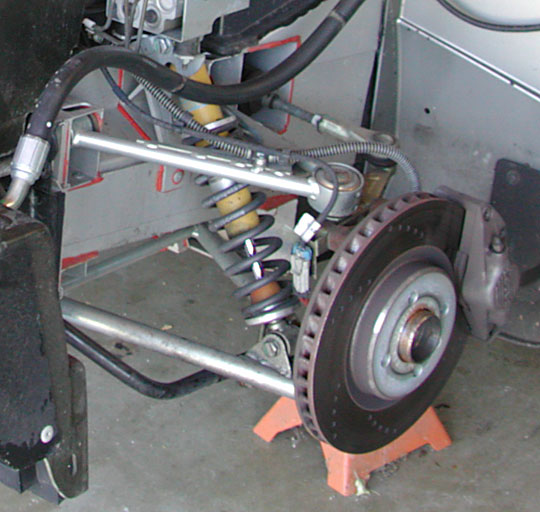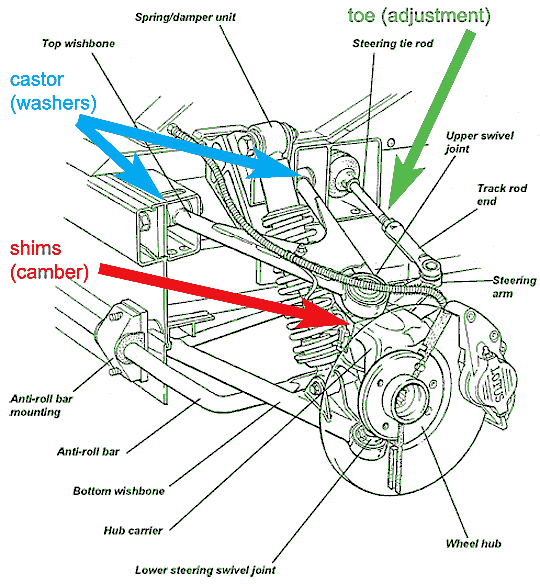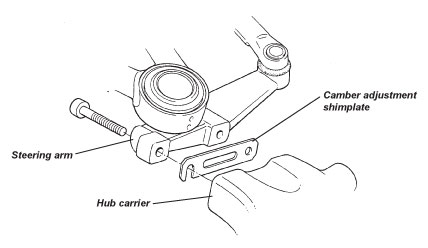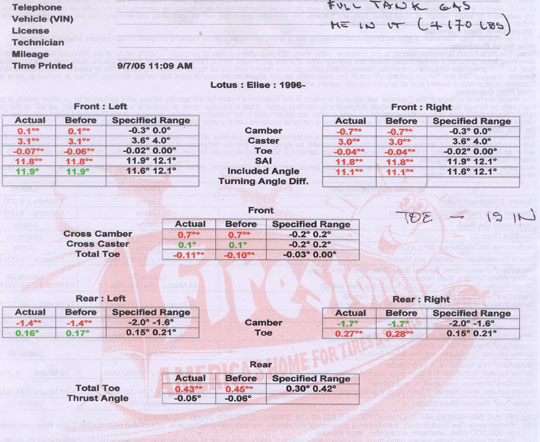
Front Suspension Alignment
The front suspension of the car locates the front wheel relative to the car and to the ground. The suspension allows the wheel to move, to steer the car, and to absorb the bumps. It also keeps the tire in the best position to achieve maximum traction.
The alignment of the front suspension controls the wheel and tire vertically (camber), forward direction (toe in or out), and the tilt of the upright forward or back (castor). The following descriptions are provided as general descriptions. The actual alignment of a car is a series of compromises and small changes can have a dramatic effect on the handling and even the safety of the car. It is strongly recommended that you read more about alignment and several references are included at the end of the page.
The alignment can be specified differently from the manufacturer's recommended values. This can enhance performance at the expense of increased tire wear, noise, braking, and even cornering. Changes in tire technology are constantly affecting the desired alignment specifications. Again, I suggest you consult one of the references. The values provided below are to provide an idea about the size and type of measurement and are not specific to the Elise.
Castor
Watch the front castors (wheels) of a shopping cart as you steer it through the aisles and notice how they always point ahead. They swivel because the point of ground contact is behind the pivot line where it extends down to the ground. Castor centers the steering wheel when you let go. Typical values are 3 to 7 degrees. Castor is the least important alignment specification.
Toe In or Out
Look at your feet and notice how your toes are pointed. In towards each other is toe in and out away from each other is toe out. The front wheels of the car can be adjusted in a similar manner. In general most toe alignment is with zero toe, or the tires pointing straight ahead. Sometime, in autocrossing for example, the toe is set to several mm out. This sets the sidewall so that turn in to a corner is quicker.
Camber
Camber is the tilt of the tire and wheel when viewed from the front or rear. When the top of the tire is tilted towards the middle of the car, the tire has negative camber. Camber helps the tire stay verticle when the car is in the middle of a corner and the body is rolling to the outside. Typical values are .5 degrees negative and racing applications prefer more, 1.5 to 2.5 degrees.
Ride Height and Corner Weights
It is possible to adjust the right height of the Elise by adjusting the spring perch on the shocks. The car can be raised and lowered within a small range. By adjusting the height of individual spring perches differently across the car, the weight can be transferred so that it is more even at all four corners. The stock and LSS suspension setups do not have sufficient fine adjustment range to make this worthwhile.

Lotus Elise Suspension
It is possible to do a reliable alignment using some simple tools. You will need fishing line or other fine string, four jack stands, a digital lever or camber gauge, and a long stick with nails or tape measure. I suggest a search on Google for "suspension alignment string".
The color coded picture above shows the three adjustment points. The blue arrows point to the location of the castor adjustment. Washers are removed or added to the pivot points of the top A arm, moving it toward the front or rear of the car.
The green arrow points to the toe adjustement. The lock nut is loosened and the track rod is twised to lengthen or shorten the distance to the steering arm. There is an adjustment on both sides of the car and this allows the steering wheel to point straight ahead and still change the toe of each wheel individually.
Finally the red arrow points to the camber adjustment. There are shims between the upper A arm mounting point and the upright. The upright is the vertical part that connects the upper and lower A arms, and the bearing for the wheel. Shims can be added to decrease the camber or removed to increase the camber.
Changing one specification will affect the measurement of the others. For example, changing the camber will affect the toe setting.

Shim Removal and Installation
Notice how the shim is slotted at the rear end and has a hole at the forward end. In order to remove a shim, remove the ____ bolt that holds the steering arm to the hub carrier. Loosen the ____ bolt and the shim can be rotated up and removed.
A 1mm shim plate will alter camber by approximately 0.25degrees°.
Apply Loctite to the two steering arm fixing bolts, and tighten to 45 Nm.
(add picture of Allen head socket, dimension, and location of torque wrench.)

Alignment Specifications
The above chart is the first alignment check for my Elise. The specified range is incorrect and the values below should be used. Note the different camber reading between left and right and the toe in. Later adjustment provided 1.4 degrees negative camber on both sides and zero toe.
It is important to settle the car much like it will be used. For example, the alignment should be done when the car has half a tank of gas and the weight of a driver included. Because the Elise is so light and the alignment is so critical to the performance of the car, the weight of the driver in the seat will have a large impact on the settings.
Standard Elise Mid-laden (ride height reference for geometry check)
| Height | front | 130 mm below front end of chassis siderail | ||
| rear | 130 mm below rear end of chassis siderail | |||
| Camber | optimum | – 0.1degrees° | ||
| tolerance | + 0.1degrees° to - 0.3degrees°; Max side/side 0.2degrees° | |||
| Castor | optimum | + 3.8degrees° | ||
| tolerance | + 3.5degrees° to + 4.1degrees°; max. side/side: 0.35degrees° | |||
| Alignment | optimum | Zero | ||
| tolerance | 0.5 mm toe-out to 0.7 mm toe-in overall (0.07degrees° toe-out to 0.10degrees° toe-in overall) | |||
| Steering axis inclination | 12degrees° nominal |
Comments from Arno of EliseTalk
Umm.. As the toe is super-super sensitive I would not share that opinion.
Adjustment on the steering arms you're talking about fractions of turns and not even full turns.
When I adjust the alignment on my car using a Hunter rig I always have to be very careful to allow some margin before tightening the locknuts. Just the locknut tightening will change the toe by 2 minutes or so, which in the Elise's case is significant.
I'd stay away from touching the toe settings when not on an alignment rig.. But that's just me..
Changing the camber is actually a piece of p*ss and can be done in about 10 minutes. Just jack up one side, remove wheel, undo 2 bolts, add or remove shims (discrete 'steps', so once you know your baseline you can simply do the math), put new loctite on bolts, put bolts back and re-install wheel. Done..
Changing the front camber does not have an effect on the toe settings on the Elise (or very, very minor) as the camber shims are between the steering arm and the hub carrier.
Caster adjustment is not easy and does take a long time as you have to undo the wishbones. But that's hardly ever required to be changed.
Bye, Arno.
This is for the S2, but I suspect the 111R/Fed-Elise is the same.
There are 2 shim thickness types used. 1mm and 3mm. A 1mm shim changes the camber by 0.25 degree.
On the 111R/Fed-Elise there ABS sensor bracket is actually a shim too, so if you want to remove that you need to use some cable-ties to attach the connector to the wishbone.
True. I run my Elise with -1 front and -2 degree camber and at 15 minutes total toe OUT at the front and about 30 minutes total toe IN at the rear for both road and track. I like it a lot.
I just question how accurate you can set and re-set the toe by using something as 'coarse' as a paint mark.
I guess you'll just need to try it and later on re-check the car on an alignment rig to see how accurately you canchange and then 'reset' it while on the track of if it ends up off too much.
The Elise is very sensitive to alignment settings and it quickly doesn't 'feel right' if you're only off a little (something you probably would not ntice on other cars at all unless you're off by a huge margin).
Bye, Arno.
References
Lotus Service Notes, Section CI
Fred Puhn. "How to Make Your Car Handle". Los Angeles: HP Books, 1981
Ben Alexander. "Performance Handling". Osceola, WI: Motorbooks International 1991
and if you are really serious,
William F. Milliken and Douglas L. Milliken. "Race Car Vehicle Dynamics". Warrendale, PA: SAE, 1995/
